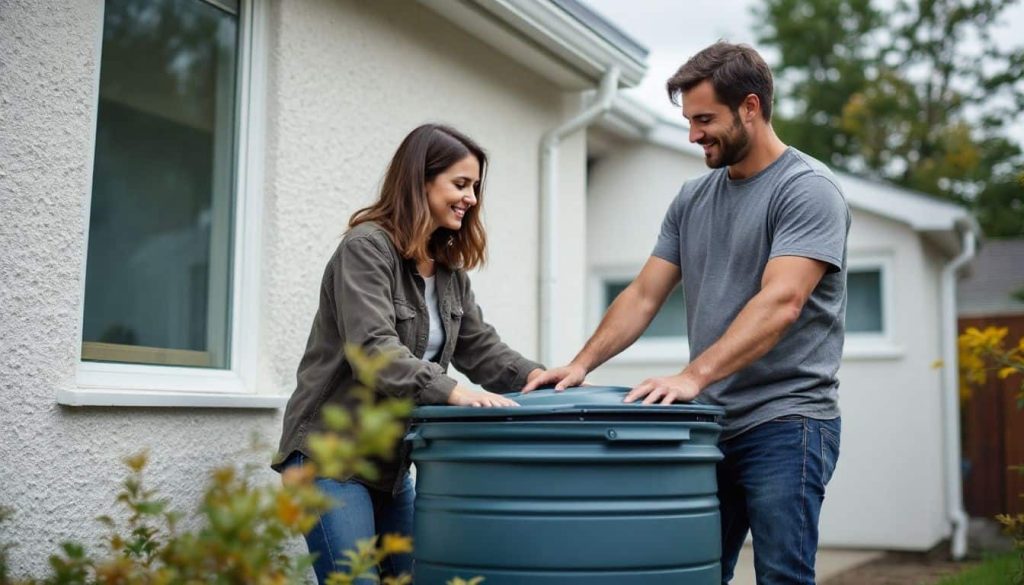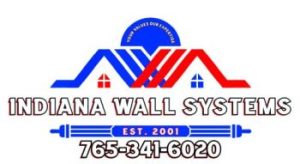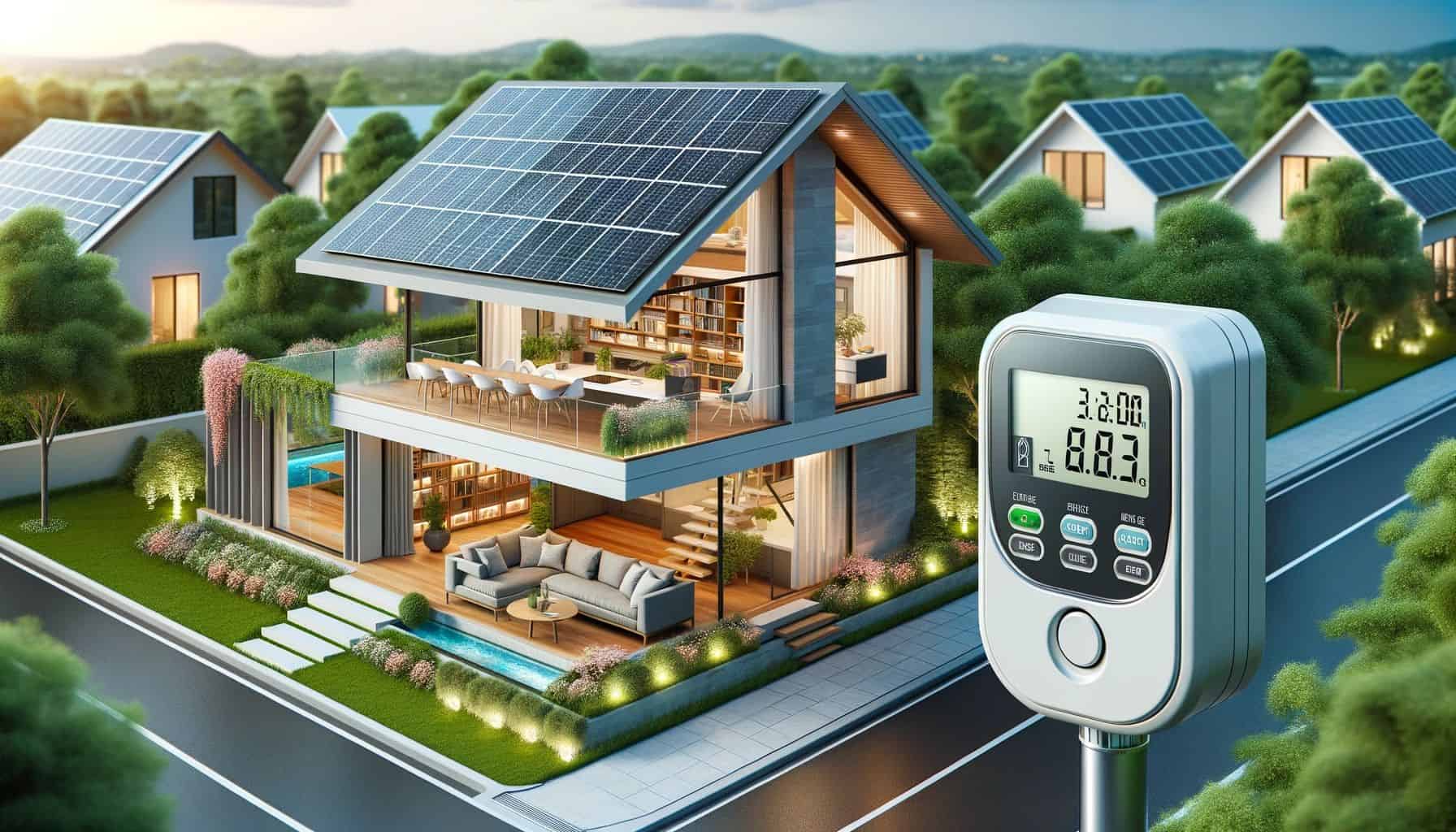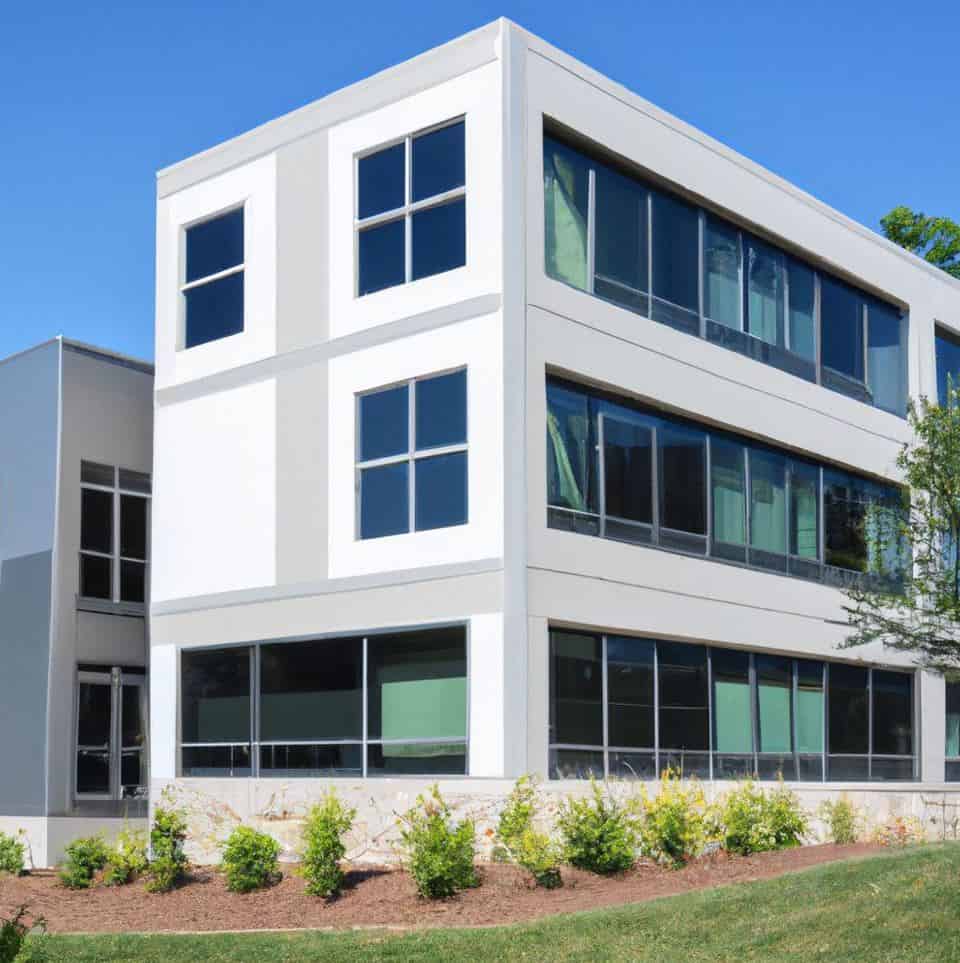Pair EIFS With Indiana Rainwater Harvesting to Cut Costs and Boost Sustainability
Water bills keep rising, and you want to save money. Rainwater harvesting can cut your water use by up to 30%. This blog will show you how to pair rainwater harvesting with EIFS for eco-friendly homes.
Ready to slash your water costs?
Key Takeaways
- Rainwater harvesting can cut water use by up to 30% and save money on bills.
- EIFS (Exterior Insulation and Finish System) reduces energy use by 30% and CO2 emissions by 40%.
- Pairing EIFS with rainwater harvesting improves water management and can lower flooding costs by up to 30%.
- A 2020 study found rainwater harvesting could meet 15-30% of non-drinking water needs over 20 years.
Understanding Rainwater Harvesting

Rainwater harvesting is a smart way to save water. It collects rain from roofs and stores it for later use.
What is Rainwater Harvesting?
Rainwater harvesting is a simple yet powerful way to save water. It involves collecting and storing rain from roofs and other surfaces for later use. This eco-friendly practice helps reduce reliance on city water supplies and cuts down on water bills.
Indiana does not have statewide regulations on rainwater harvesting, but it’s wise to contact local county authorities or Indiana Wall Systems for potential incentives or guidelines.
Rainwater harvesting is nature’s gift to sustainable living.
The stored water can be used for many things around the home. Watering gardens, flushing toilets, and washing cars are just a few examples. To get started, you’ll need a system that can hold at least 250 gallons.
Indiana residents interested in rainwater harvesting and related conservation practices have access to resources and support through local organizations. For instance, the Indiana Department of Environmental Management (IDEM) offers guidance on installing rain barrels, which are systems designed to collect and store rainwater from rooftops for future use in gardens and lawns. Utilizing rain barrels can help reduce stormwater runoff and conserve treated water.
Additionally, some local entities, such as Solid Waste Management Districts and Soil and Water Conservation Districts, may offer workshops or sell rain barrels to promote water conservation practices. For example, the Marion County Soil and Water Conservation District provides rain barrels for purchase.
Importance of Rainwater Harvesting in Sustainable Development
Rainwater harvesting plays a key role in sustainable development. It helps manage stormwater, reduces flooding, and provides an extra water supply. A big city study in 2020 found that rainwater harvesting could meet 15-30% of non-drinking water needs over 20 years.
This means less strain on city water systems and lower water bills for homeowners.
Collecting rainwater also cuts down on runoff, which can cause erosion and pollution. Another major city study showed that rainwater harvesting reduced flooding costs by up to 30%.
For homeowners, this means a greener yard and less worry about water damage. Plus, using rainwater for tasks like watering plants or washing cars saves money and helps the planet.
Basics of EIFS (Exterior Insulation and Finish System)
EIFS offers a modern take on traditional stucco. This system combines insulation and a weather-resistant finish to create an energy-efficient building envelope.
Overview of EIFS
EIFS stands for Exterior Insulation and Finish System. It’s a modern wall cladding that looks like stucco but works much better. This system has many layers that work together to keep homes warm and dry.
The outer layer is tough and pretty, while the inner layers block heat and moisture.
EIFS is like a protective shield for your home, keeping it cozy and dry.
EIFS offers great benefits for homeowners. It cuts energy bills by up to 30% and lasts for 50 years with little upkeep. The system also lets you pick from many colors and textures to make your home look just how you want.
Plus, EIFS is light and easy to put on, which can save money during building or remodeling.
Key Features of EIFS
EIFS offers homeowners a smart way to protect and insulate their homes. This system uses layers of materials to create a strong, energy-saving shell. It starts with foam insulation boards fixed to the wall.
Then, a special mesh and base coat go on top. Finally, a finish coat adds color and texture. The result? A home that stays warm in winter and cool in summer.
One big plus of EIFS is its ability to cut energy use by 30%. It also helps lower CO2 emissions by 40%. Plus, it’s tough – it can stand up to impacts and moisture. For eco-minded folks, EIFS is a win.
It reduces material waste by 75% compared to other options. All these features make EIFS a top choice for homes that save energy and look great.
Moisture Management Techniques for EIFS
EIFS needs good moisture control to work well. Smart builders use special methods to keep water out. They add a drainage plane behind the EIFS. This lets any water that gets in flow away safely.
They also use vapor barriers to stop moisture from moving through walls.
Proper sealing is key for moisture control in EIFS. Builders carefully seal all joints and openings. This stops water from sneaking in. They also make sure the EIFS coating is put on right.
A good coat forms a strong barrier against rain and snow. These steps help EIFS homes stay dry and last longer.
EIFS Home Weatherproofing Guide
Moving from moisture management, let’s focus on how to weatherproof your home with EIFS. This guide will help you protect your house from the elements.
EIFS acts as a shield for your home. It keeps water out and heat in. The system has many layers that work together. First, there’s a water-resistant barrier. This stops moisture from getting into your walls.
Next comes insulation. It helps save energy and keeps your home cozy. The top layer is a special finish. It’s tough and looks great. EIFS also has a built-in drainage system. This moves water away from your walls.
It’s a smart way to avoid mold and rot. With EIFS, your home stays dry and comfy all year round.
Role of EIFS Inspections in Sustainable Building Practices
EIFS inspections play a key role in sustainable building. These checks ensure the system works well and lasts long. Experts look for any weak spots or damage that could let moisture in.
They also make sure the insulation is doing its job. Regular checks help keep homes energy-efficient and free from mold.
Good inspections lead to better indoor air quality. They help EIFS systems last up to 50 years with little upkeep. This means less waste and fewer repairs over time. Proper EIFS care also blocks noise and keeps out pollutants.
Next, let’s look at how EIFS and rainwater harvesting work together.
The Synergy Between Rainwater Harvesting and EIFS
EIFS and rainwater harvesting work great together. They boost water management and help collect rain.
How EIFS Enhances Water Management
EIFS plays a key role in water management for homes. It acts as a shield, keeping water out of walls and foundations. The system includes a drainage plane that guides water away from the building.
This helps prevent moisture damage and mold growth inside walls.
In coastal areas, EIFS has proven its worth against harsh storms. Its integrated drainage system and moisture barrier work together to protect homes. EIFS also blocks pollutants and cuts down on noise.
These features make it a smart choice for homeowners who want to manage water and boost their home’s durability.
Integration of EIFS With Rainwater Collection Systems
EIFS works well with rainwater collection systems. It helps guide water to storage tanks. The smooth surface of EIFS lets rain flow easily into gutters and pipes. This setup can catch more rainwater for later use.
Homeowners can save money and help the planet with this combo. An indepth study showed it cut costs by 48%. It also helps stop sewers from overflowing when it rains hard. Plus, EIFS keeps your home dry and comfy inside.
It’s a smart choice for eco-friendly living.
Environmental Benefits of Pairing EIFS With Rainwater Harvesting
EIFS and rainwater harvesting team up to cut water waste. They also help manage stormwater better, which is good for the earth.
Reduced Water Runoff
Rainwater harvesting cuts down on water runoff from your home. This means less water flows into storm drains and local waterways. A study in Melbourne found that it can lower flooding costs by up to 30%.
This is great news for homeowners who want to help their community and save money.
EIFS homes work well with rainwater harvesting systems. They guide water away from walls and into collection tanks. This stops water from pooling near your house, which can cause damage over time.
Plus, you’ll have extra water for your garden or lawn during dry spells. It’s a win-win for your wallet and the planet.
Improved Stormwater Management
EIFS and rainwater harvesting team up to tackle stormwater issues. This duo helps manage heavy rains and floods. They work by slowing down water flow and soaking it into the ground.
This cuts down on runoff that can harm local water bodies. In coastal areas, EIFS has shown its strength against severe storms. It keeps buildings dry and safe, even in harsh weather.
Indiana homeowners can use this pair to protect their property and help the environment. EIFS acts as a shield, keeping water out of walls and foundations. Rainwater systems catch and store water for later use.
This combo reduces strain on city water systems during big storms. It also provides free water for gardens and lawns. Plus, it helps keep basements dry and prevents soil erosion around homes.
Lower Carbon Footprint
EIFS and rainwater harvesting team up to slash carbon footprints. These systems cut CO2 emissions by 40% and energy use by 30%. They also trim material waste by 75%. This means less strain on the planet and more money in your pocket.
Your home becomes a green machine, working hard to protect the earth.
Green building practices don’t stop there. The next step is to look at water efficiency. Let’s explore how EIFS and rainwater harvesting boost water savings in your home.
Water Efficiency Achieved With EIFS and Rainwater Harvesting
EIFS and rainwater harvesting work together to boost water efficiency. This helps homes save water and reuse it for many tasks.
Water Reclamation and Reuse
Water reclamation and reuse offer smart ways to save water at home. This process cleans used water so it’s safe for other tasks. You can use reclaimed water for watering plants, flushing toilets, or washing cars.
It’s a great way to cut down on water bills and help the environment.
A 2020 study found that water reuse could meet 15-30% of non-drinking water needs over 20 years. This shows how much water we can save through reclamation. Many cities now offer programs to help homeowners set up these systems.
Supporting Greywater Systems
EIFS homes can work well with greywater systems. Greywater is the used water from sinks, showers, and washing machines. It’s not clean enough to drink, but it’s great for watering plants.
EIFS walls help keep this water away from your home’s structure. They act as a barrier, stopping moisture from getting in.
You can set up pipes to collect greywater and use it in your yard. This saves clean water for drinking and cooking. The EIFS on your home will protect it from any extra moisture. It’s a smart way to use water twice and keep your home dry.
Plus, it cuts down on your water bill and helps the environment.
Enhancing Building Longevity With EIFS and Rainwater Harvesting
EIFS and rainwater harvesting work together to protect buildings. They keep moisture out and extend a structure’s life.
EIFS as a Protective Barrier Against Moisture
EIFS acts as a strong shield against water damage. It forms a tight seal around your home, keeping moisture out. This system has many layers that work together to stop water from getting in.
The outer layer sheds water, while the inner layers block any that sneaks through.
Homes with EIFS stay dry even in harsh weather. A building stood firm against big storms thanks to its EIFS cover. This shows how well it guards against moisture. With proper care, EIFS can protect your home for up to 50 years.
Next, let’s look at how EIFS and rainwater harvesting work together to save water.
Reducing Water Damage in Building Structures
EIFS acts as a shield for your home. It keeps water out and stops damage to walls and floors. A study showed zero moisture problems in homes with EIFS. This means less worry about mold, rot, or costly repairs.
EIFS also helps manage rainwater, guiding it away from your house.
Pairing EIFS with rainwater harvesting creates a powerful duo. The system collects rain from your roof and stores it for later use. This cuts down on water bills and helps the environment.
Plus, it reduces stress on city sewers during storms as another study proved this method works well in urban areas.
Cost-Effectiveness of Implementing EIFS and Rainwater Harvesting
EIFS and rainwater harvesting can slash water bills and cut maintenance costs. These systems work together to save money and boost a home’s value over time.
Savings in Water Bills
Rainwater harvesting can slash your water bills plus, these systems work great for watering plants. You’ll use less tap water, which means lower bills each month.
Plus, some places offer money back for installing these systems. A mix of methods can cut costs by 48%. That’s almost half off!
With these systems, you can keep your yard green without seeing red on your bills.
Reduced Maintenance Costs
EIFS and rainwater harvesting systems can slash your home’s upkeep costs. These systems need little care, lasting up to 50 years with minimal fuss. You’ll save money on repairs and replacements over time.
Plus, you’ll cut water bills by using collected rainwater for tasks like watering plants or washing cars.
Your home stays drier and cleaner with EIFS, which fights mold and rot. This means fewer paint jobs and less wood rot to fix. The rainwater system also helps by moving water away from your house’s base.
Together, they protect your home and wallet for years to come.
Applications of Rainwater Harvesting and EIFS in Green Building
Green buildings use rainwater harvesting and EIFS to save water and energy. These systems work in homes, offices, and city projects to make buildings more eco-friendly.
Residential Projects
Homes can use EIFS and rainwater harvesting to save money and help the planet. EIFS acts like a shield for your house, keeping it dry and cozy. It also helps catch rain, which you can use for many things.
You could water your garden or wash your car with this saved water. This combo cuts water bills and makes your home more eco-friendly.
Many new homes now include these systems from the start. They’re easy to add to older houses too. Builders love EIFS because it’s quick to put up and looks great. Rainwater tanks can be hidden underground or made to look nice above ground.
Together, they make homes stronger, cheaper to run, and kinder to nature.
Commercial Developments
Commercial buildings can use EIFS and rainwater harvesting to save money and help the planet. These systems work great for big structures like offices, malls, and hotels. They cut water use and energy costs while making buildings last longer.
Many companies now choose these eco-friendly options to meet green building rules and please customers who care about the earth.
EIFS keeps buildings warm or cool with less power. Rainwater systems collect water for toilets, plants, and cleaning. Together, they make a building work better and cost less to run.
Municipal Infrastructure
Cities can use rainwater harvesting and EIFS to improve their water systems. These tools help manage stormwater and reduce flooding. This means less strain on city water supplies and lower costs for taxpayers.
EIFS plays a key role in this process. It acts as a barrier, keeping water out of buildings while allowing collected rainwater to be used. This combo can cut water bills and upkeep costs.
It also helps cities meet green building codes and become more eco-friendly. With these systems, towns can better handle heavy rains and save money in the long run.
Case Studies of Successful EIFS and Rainwater Harvesting Projects
Real-world examples show how EIFS and rainwater harvesting work together. A city project in Portland, Oregon cut water use by 50% using these methods. Want to learn more about this success story?
Urban Rainwater Management Solutions
Urban areas face big water problems. Too much rain can flood streets and homes. But smart solutions help. Cities use special systems to catch and use rainwater. These systems include things like rain gardens and porous pavement.
They soak up water and stop floods. These fixes save money and make cities safer. They also help the earth by using less water from other sources.
Sustainable Housing Developments
Eco-friendly homes are on the rise. These houses use less energy and water, cutting bills and helping the planet. Many have EIFS walls that keep heat in and moisture out. They also catch rainwater to use in gardens or toilets.
This smart design can save up to 50% on water use. Green homes often last longer too, needing fewer fixes over time.
Some new housing projects go even further. They create whole neighborhoods that work with nature. These areas have parks, bike paths, and shared gardens. They use solar power and have systems to clean and reuse water.
People who live here enjoy fresh air, quiet streets, and lower costs. It’s a win for both families and the earth.
Challenges and Solutions for Combining EIFS With Rainwater Harvesting
Combining EIFS with rainwater harvesting poses design and installation hurdles, but smart planning can solve these issues. Read on to learn more about overcoming these challenges.
Addressing Design Limitations
Design limits can be tricky when mixing EIFS with rainwater systems. Homes need proper planning to avoid issues. Experts must check the building’s shape and size. They also need to look at where gutters and pipes will go.
Good design makes sure water flows right and doesn’t harm the EIFS.
Smart choices help beat these limits. Use the right materials that work well together. Plan spaces for tanks and filters. Make sure the EIFS and water system don’t clash. With care, you can have a great eco-friendly home.
Next, let’s look at how to handle installation hurdles.
Overcoming Installation Hurdles
Installing EIFS with rainwater harvesting can be tricky. But smart planning makes it easier. First, pick the right spot for your water tank. Make sure it’s close to downspouts and away from your home’s foundation.
Next, use proper sealing methods where EIFS meets gutters and pipes. This stops leaks and keeps your walls dry. Good drainage is key too. Add a slope away from your house to guide water where you want it.
Training is vital for smooth installation. Hire pros like Indiana Wall Systems who know both EIFS and rainwater systems. They’ll avoid common mistakes that can lead to big problems later. With the right team, you can enjoy a dry home and free water for years to come.
Let’s look at future trends in EIFS and rainwater harvesting.
Future Trends in Rainwater Harvesting and EIFS Integration
Smart tech will make EIFS and rainwater systems work better together. Read on to learn about exciting changes coming to eco-friendly buildings!
Advancements in EIFS Technology
EIFS tech keeps getting better. New materials make walls stronger and more energy-smart. Improved coatings fight mold and last longer. These upgrades help homes stay dry and comfy.
They also cut energy bills by up to 30%. That’s good news for your wallet and the planet.
Makers now add special stuff to EIFS that cleans the air. It breaks down smog and other bad things. Some new EIFS can even heal small cracks on their own. This means less work for you to keep your home looking great.
With these cool new features, EIFS is more than just a wall – it’s a high-tech shield for your house.
Smart Systems for Rainwater Collection and Usage
Smart systems make rainwater collection easy and useful. These systems use sensors and tech to gather and manage rainwater. They can check water levels, filter out dirt, and send water where it’s needed.
Some even link to your phone, letting you control water use from anywhere. This helps ensure enough water is stored for dry times. Next, let’s look at future trends in how EIFS and rainwater systems will work together.
Conclusion
Rainwater harvesting and EIFS make a powerful team for eco-friendly homes. They cut water waste, save money, and help the planet. This duo creates buildings that last longer and use less energy.
As more people choose these options, we’ll see greener cities and happier homeowners. It’s a smart move for anyone who wants to live in a home that’s good for the earth and their wallet.
FAQs
How does EIFS work with rainwater harvesting?
EIFS, or synthetic stucco, pairs well with eco-friendly water solutions. It acts as a weather barrier and thermal shield, helping to control runoff. This system can be part of a green infrastructure plan, working with permeable surfaces and bioswales to manage storm water.
Can EIFS help in water conservation efforts?
Yes! EIFS coatings are waterproof and vapor permeable. They stop water from getting in while letting moisture out. This helps prevent mold and keeps buildings dry. When used with water catchment systems, EIFS can boost water conservation in homes and buildings.
What are some eco-friendly options for rainwater harvesting?
There are many choices! You could install a water storage tank, create an infiltration basin, or build a green roof. Drip irrigation and xeriscaping are great for saving water in landscaping. These methods can help you build a more sustainable home.
Is it hard to add rainwater harvesting to an existing building?
Not at all! You can retrofit most buildings for rainwater harvesting. It might mean adding a drainage layer or changing your landscaping. The key is good planning. Make sure to check local codes and think about the building’s structure before you start.
How does rainwater harvesting affect a building’s energy use?
Rainwater harvesting can lower energy needs in several ways. It can reduce the strain on air conditioning systems by cooling the building naturally. When paired with EIFS, it creates a strong thermal barrier. This combo can lead to big savings on energy bills!
Are there any drawbacks to using EIFS with rainwater harvesting?
While EIFS is great for many reasons, it needs proper installation. If not done right, it could lead to water issues. Also, some historic buildings may not suit EIFS. But for most new builds or updates, EIFS and rainwater harvesting make a smart, eco-friendly team.





